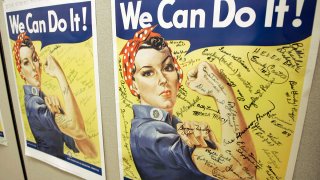
During World War II, thousands of women left their homes and entered the workforce, to help the United States win the conflict.
One of those women was Mary Fierros, who, like many Latinas in the U.S., was part of a workforce with an important mission.
"They gave me an apron, I put the apron on, and then they told me 'you have to go get the gun,'" Fierros recalled.
"I said 'Oh my God! The gun!' They told me, 'Yes.' I told them I'd never touched a gun, and they told me 'That's a riveter machine, Mary!'" she said. "I didn't know the difference."
Get San Diego local news, weather forecasts, sports and lifestyle stories to your inbox. Sign up for NBC San Diego newsletters.
Mary Fierros is now 102 years old, and lives in San Jose. She worked for the Douglas Aircraft company while her husband was doing his military service.
"'And then there are going to be two of them, you are going to be the riveter, and your partner is going to be the bucker,'" Fierros said, recalling the instructions they received. "'When you put the rivets on the airplane wings, she has to buck the rivets on the outside.' My God, alright."
They knew what they were building, but they had to show discretion.
"They told me we couldn't talk to anyone. My partner, I never knew her name, because I couldn't ask her what country she was from," Fierros recalled.
"I know she couldn't speak English, because when she needed something she had to talk to me so I could translate what she was saying."
Latinas living in Mexico also participated, as in the case of Francisca Miranda. She lived in Tiajuana, but had permission to cross the border for her job.
"When you're 18 years old, they accepted the paper you filled out and everything," Miranda remembered. "It was very different when one didn't know English, and different when one enters the workforce without knowing the language," Miranda said.
"And when they eventually put us with a worker who spoke English, we spoke English better than that lady."
Despite the language barrier they faced, the group of women left an indelible mark.
The Latina 'Rosies'
Fierros and Miranda were just two of thousands of women who left their homes to join the war effort while their husbands were away defending the country. The program is now known for the name Rosie the Riveter.
"The government, through various propaganda ads, started to say 'Help us with the war so the men come home soon,'" said Adriana Sneloff, of the Rosie the Riveter WWII Home Front National Park.
Many of the Rosies' experiences have been documented in the museum dedicated to them in Richmond, California.
"How many people in the next generation know about Rosie?" said Sneloff.
"That's what the national park is doing here, helping to contribute to that history that made incredible changes to society, opened the doors to women working. They made a lot of progress in human rights and race relations."
Alice Ann Virchis, Miranda's daughter, knows her mother never realized how important Mexican women were during that period.
"My mom doesn't recognize the importance of women during the war, those who participated in what she did, in big cities like Chicago, in Pennsylvania," Virchis said.
"In all of those factories, all around the country, there were Mexican women working."
Discrimination Despite Their Work
It's not known exactly how many Latina Rosies there were at the time. The environment surrounding race at the time influenced the lack of knowledge now.
"Mexicans who were more or less light-skinned were considered white," Sneloff said. "In other words, in many ways, they were integrated by force. But when white people found out they were Mexican, there was some hostility."
Fierros witnessed the hostility firsthand. She remembers that she had to sit in the back of the bus, next to Black people who were also segregated.
"I saw them, and said, 'My God, no more,'" Fierros said. "Because I'm Mexican I can't sit here. So I would sit down and they would turn like this [to one side]. They didn't even want to touch me because I was Mexican."
Latina Rosies have become an important part of U.S. history during World War II, forging a path as an example for future generations.
"What women did during that era was unforgettable, because who was going to make the planes? Who was going to make the jeeps, or the tanks?” Virchis said.
This story was translated from our sister station, Telemundo 52. Para leer en español, haga clic aquí.



